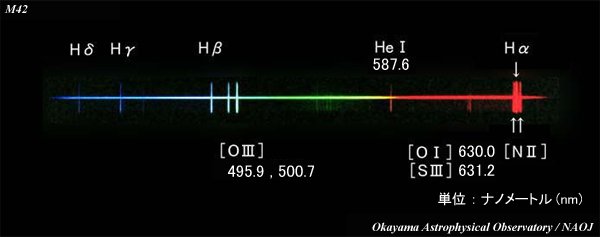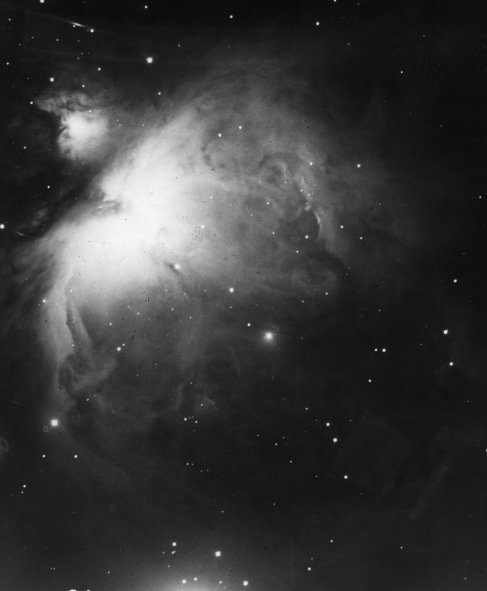THE ORION NEBULA
North is up and a bit to the left. The Orion Nebula (Messier 42),
which appears to surround the central star in
Orion's Sword , is a vast cloud of
interstellar gas and dust some 20 light years across that is lit
by a quartet of hot stars (the
Trapezium) at its
apparent center. Some 1500 light years away, the Trapezium and Nebula
lie in front of a cold, dusty "giant molecular cloud" that hosts
regions of intense star formation. The stars of the Trapezium electrify
a blister on the front edge of the molecular cloud, which
makes it glow. The small nebula that seems attached at the upper left edge of the
main nebula is Messier 43, which is separated from M 42 by a dust lane. The stars and nebula are
no more than two or so million years old. The glow at the bottom is coming from the
massive multiple star Iota Orionis. (The weak squarish feature at lower
right and the streak at upper left are caused by internal reflections in the optics.)

|
Above is the visual spectrum
of the Orion Nebula from a wavelength just
to the long side of the Hydrogen-Alpha line at 6563 Angstroms to
just shortward of H-Delta at 4101 Angstroms. (The wavelength scale is in
nanometers; multiply by 10 to get Angstroms.) Energetic ultraviolet starlight
(most of which comes from the hot
class O6 star
Theta-1 Orionis C) ionizes a
portion of the molecular cloud, that is, it strips
electrons from the nebula's atoms, which are mostly hydrogen. When the charged ions
recombine with the free electrons, the energy is given back up as light
in the form of emission lines. The Hydrogen Alpha line
helps give much of the nebula its reddish color. From the strong neutral helium line
at 5876 Angstroms we can get the abundacnce of helium relative to
that of hydrogen.
Additional "forbidden" emission lines
(forbidden under simplified theory, but strong in nebular spectra)
are produced by collisions between electrons and ions, which elevate the ions' electrons to
excited states from which they descend, again releasing energy. The strong forbidden lines
(indicated by square brackets) of doubly ionized oxygen ([O III}) just left of
give a greenish glow to the nebula's central portion, while those of ionized nitrogn that
bracket H-Alpha add to the general red color of the outer portions of the nebula.
Not shown, to the right of the H-Alpha and [N II] lines are a pair of strong
forbidden lines of ionized sulfer ([S II]), while to the left of H-Delta is a pair of strong
forbidden llines of ionized oxygen ([O II]), as seen in the spectra of the
planetary nebulae
BV-1, the
Ring Nebula, NGC 7009,
and IC 418.
Weak forbidden lines of neutral nitrogen show up near dead center.
Photo: University of Illinois Prairie Observatory; spectrum: Okayama Astrophysical Observatory, NOAJ.


